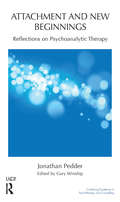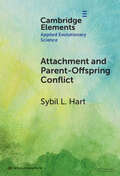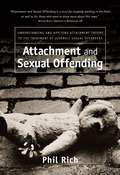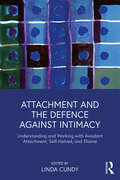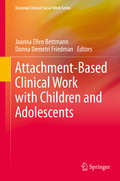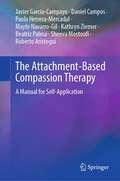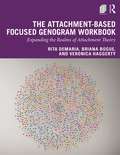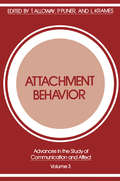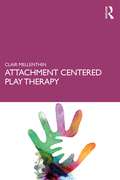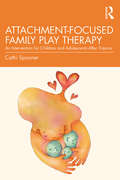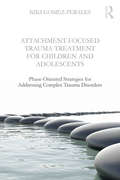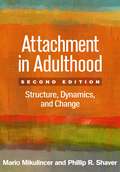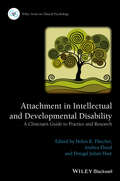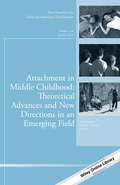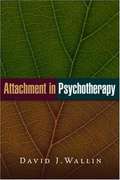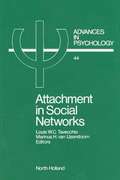- Table View
- List View
Attachment and New Beginnings: Reflections on Psychoanalytic Therapy (The\united Kingdom Council For Psychotherapy Ser.)
by Jonathan PedderThis collection of written pieces plots the work of an NHS psychotherapist, Jonathan Pedder, turning the science of psychiatry into human encounters. He had a career teaching and inspiring colleagues and students with psychoanalytic ways of thinking, encouraging and supporting them in the challenges of contemporary psychiatry. In his work he made the world of psychoanalysis accessible to non-analysts, and this book augments the textbook on psychotherapy which Pedder wrote with Dennis Brown. Pedder was a quiet visionary influential in offering a pathway for mental health workers from many disciplines to find their way to the psychoanalytic ideas that illuminate their patients/clients.'- Professor R. D. Hinshelwood, Author of Clinical Klein and Dictionary of Kleinian Thought.
Attachment and New Beginnings: Reflections on Psychoanalytic Therapy
by Jonathan PedderThis collection of written pieces plots the work of an NHS psychotherapist, Jonathan Pedder, turning the science of psychiatry into human encounters. He had a career teaching and inspiring colleagues and students with psychoanalytic ways of thinking, encouraging and supporting them in the challenges of contemporary psychiatry. In his work he made the world of psychoanalysis accessible to non-analysts, and this book augments the textbook on psychotherapy which Pedder wrote with Dennis Brown. Pedder was a quiet visionary influential in offering a pathway for mental health workers from many disciplines to find their way to the psychoanalytic ideas that illuminate their patients/clients.'- Professor R. D. Hinshelwood, Author of Clinical Klein and Dictionary of Kleinian Thought.
Attachment and Parent-Offspring Conflict: Origins in Ancestral Contexts of Breastfeeding and Multiple Caregiving (Elements in Applied Evolutionary Science)
by null Sybil L. HartThis Element builds on the mainstream theory of attachment and contemporary understanding of the environment of evolutionary adaptedness to address the origin and nature of infant-maternal bond formation. Sections 2 and 3 propose that attachment behaviors for protesting against separation and usurpation were compelled by infants' needs for close and undivided access to a source of breast milk, usually mothers, for three years to counter threats of undernutrition and disease that were the leading causes of infant mortality. Since these attachment behaviors would not have been presented unless they were compelled by maternal resistance, their arising is also attributed to parent-offspring conflict. Section 4 theorizes that the affectional nature of infant-maternal attachment originated within contexts of breastfeeding. Uniform and universal features of exclusive versus complementary breastfeeding, that could entail diverse experiences among multiple caregivers, may have shaped adaptations so that love relationships with mothers differ from those with nonmaternal caregivers.
Attachment and Sexual Offending: Understanding and Applying Attachment Theory to the Treatment of Juvenile Sexual Offenders
by Phil RichThis book provides a broad overview of the literature, theory, and clinical treatment of attachment deficit. It discusses its application in understanding the etiology of juvenile sexual offending, as well as implications for treatment. Issues addressed include the components of attachment and social connection, attachment and the development of personality, neurology and attachment, the development of social competence, and consideration of whether attachment can be learned.
Attachment and the Defence Against Intimacy: Understanding and Working with Avoidant Attachment, Self-Hatred, and Shame
by Linda CundyThis book combines attachment theory and research with clinical experience to provide practitioners with tools for engaging with individuals who are indifferent, avoidant, highly defensive, and who struggle to make and maintain intimate connections with others. Composed of four papers presented at a Wimbledon Guild conference in 2017, this text examines the origins of avoidant attachment patterns in early life, describes research tools that offer a more refined understanding of this insecure attachment pattern, explores the internal object worlds of "dismissing" adults, and considers the impact on couple relationships when one or both partners avoid intimacy or dependency. Each chapter contains case studies with children and families, adolescents, adults and couples that acknowledge the challenges of engaging with these "shut down" individuals, with authors sharing what they have learned from their patients about what is needed for effective psychotherapy. It is an accessible book full of clinical richness and insight and will be invaluable to practitioners who are interested in deepening their understanding and clinical skills from an attachment perspective.
Attachment and the Defence Against Intimacy: Understanding and Working with Avoidant Attachment, Self-Hatred, and Shame
by Linda CundyThis book combines attachment theory and research with clinical experience to provide practitioners with tools for engaging with individuals who are indifferent, avoidant, highly defensive, and who struggle to make and maintain intimate connections with others. Composed of four papers presented at a Wimbledon Guild conference in 2017, this text examines the origins of avoidant attachment patterns in early life, describes research tools that offer a more refined understanding of this insecure attachment pattern, explores the internal object worlds of "dismissing" adults, and considers the impact on couple relationships when one or both partners avoid intimacy or dependency. Each chapter contains case studies with children and families, adolescents, adults and couples that acknowledge the challenges of engaging with these "shut down" individuals, with authors sharing what they have learned from their patients about what is needed for effective psychotherapy. It is an accessible book full of clinical richness and insight and will be invaluable to practitioners who are interested in deepening their understanding and clinical skills from an attachment perspective.
Attachment-Based Clinical Work with Children and Adolescents (Essential Clinical Social Work Series)
by Joanna Ellen Bettmann and Donna Demetri FriedmanAttachment-Based Social Work with Children and Adolescents is a wide-ranging look at attachment theory and research, its application to youth populations, and its natural fit with the social work profession. This book covers the applicability of attachment theory to the profession’s various domains that include human behavior, practice, policy, research, and social work education. In particular, it addresses the broad spectrum of clinical social work, including practice in a variety of public and private settings and with a number of diverse populations. The book highlights the contribution of the social work profession to the development of attachment theory and research.
The Attachment-Based Compassion Therapy: A Manual for Self-Application
by Javier García-Campayo Daniel Campos Paola Herrera-Mercadal Mayte Navarro-Gil Kathryn Ziemer Beatriz Palma Sheeva Mostoufi Roberto AristeguiThis book is a manual for self-application of the Attachment-Based Compassion Therapy (ABCT) protocol, that can be either self-applied by any individual in a psychoeducational context or as a support for a therapeutic process guided by a professional. Compassion therapy is a third-generation psychotherapy that has been used in association with mindfulness in recent years. In particular, attachment-based compassion therapy (ABCT) is a protocol that can be used in both the general and psychiatric population with the aim of promoting compassion and self-compassion. ABCT is based on attachment theory and, therefore, includes practices to raise awareness and/or address maladaptive aspects, where appropriate, of the attachment styles developed with parents. This process is taught as a form of both compassion and self-compassion in order to improve present-day interpersonal relationships and well-being in general. In the face-to-face group format, ABCT has been demonstrating efficacy and applicability for healthy people and for the treatment of fibromyalgia, depression, anxiety and adjustment disorders. This book presents a self-applied version of ABCT that operates along the lines of the original model and has been adapted and developed to be fully self-applied via the Internet in 8 sequential modules:Introduction to attachment-based compassion therapyPreparing ourselves for compassion: kind attentionDiscovering our compassionate worldDeveloping our compassionate worldUnderstanding our relationship with compassionWorking on ourselvesUnderstanding the importance of forgivenessConsolidating the practice of compassion The content is presented through texts, pictures, tables and figures, including links to downloadable audio files for formal meditation practices with specific guides and instruction for each meditation. The transcripts to each guided meditation are also included as appendices.
The Attachment-Based Focused Genogram Workbook: Expanding the Realms of Attachment Theory
by Rita DeMaria Briana Bogue Veronica HaggertyThe Attachment-Based Focused Genogram Workbook is a hands-on guide for clinicians looking to integrate attachment research and family systems theory into their practice, with particular attention to intergenerational transmission processes. The book introduces a range of relationship mapping and timeline tools, grounded in the use of focused genograms and the Intersystem Approach. Examining the importance of the therapeutic bond within a variety of client-systems, the book outlines a new methodology for identifying childhood attachment patterns, adult attachment styles, family scripts and attachment narratives, and contextual social bonds. Exercises are also included throughout to encourage reflective thinking and to consolidate key concepts. Utilizing genograms as an essential tool in systemically focused family practice, this workbook will help therapists at all levels to apply and strengthen systemic considerations for clinical practice and research. The text also complements the revised edition of Focused Genograms, which uniquely applies attachment research for individuals, couples, and families in contextual clinical settings.
The Attachment-Based Focused Genogram Workbook: Expanding the Realms of Attachment Theory
by Rita DeMaria Briana Bogue Veronica HaggertyThe Attachment-Based Focused Genogram Workbook is a hands-on guide for clinicians looking to integrate attachment research and family systems theory into their practice, with particular attention to intergenerational transmission processes. The book introduces a range of relationship mapping and timeline tools, grounded in the use of focused genograms and the Intersystem Approach. Examining the importance of the therapeutic bond within a variety of client-systems, the book outlines a new methodology for identifying childhood attachment patterns, adult attachment styles, family scripts and attachment narratives, and contextual social bonds. Exercises are also included throughout to encourage reflective thinking and to consolidate key concepts. Utilizing genograms as an essential tool in systemically focused family practice, this workbook will help therapists at all levels to apply and strengthen systemic considerations for clinical practice and research. The text also complements the revised edition of Focused Genograms, which uniquely applies attachment research for individuals, couples, and families in contextual clinical settings.
Attachment-Based Milieus for Healing Child and Adolescent Developmental Trauma: A Relational Approach for Use in Settings from Inpatient Psychiatry to Special Education Classrooms
by John StewartThis book presents an innovative relational and community based therapeutic model to ensure children's essential attachment needs are catered for in intensive mental health care.The text combines an overview of theory relating to attachment and trauma before laying out a model for working with children and adolescents in an attachment-informed way. The approach applies to a diverse range of settings - from in-patient psychiatric settings, through to schools-based programs, and provides the reader with the knowledge and guidance they need to introduce the approach in their own service. It also addresses the complexities of working with specific clinical populations, including children with ADHD, ASD, RAD and psychosis. Accessible for entry level clinical caretakers, yet sophisticated enough for clinical supervisors, this book is essential reading for professionals looking to improve the effectiveness of child and adolescent treatment programs.
Attachment Centered Play Therapy
by Clair MellenthinAttachment Centered Play Therapy offers clinicians a holistic, play-based approach to child and family therapy that is presented through the lens of attachment theory. Along the way, chapters explore the theoretical underpinnings of attachment theory to provide a foundational understanding of the theory while also supplying evidence-based interventions, practical strategies, and illuminative case studies. This informative new resource strives to combine theory and practice in a single intuitive model designed to maximize the child-parent relationship, repair attachment wounds, and address underlying symptoms of trauma.
Attachment Centered Play Therapy
by Clair MellenthinAttachment Centered Play Therapy offers clinicians a holistic, play-based approach to child and family therapy that is presented through the lens of attachment theory. Along the way, chapters explore the theoretical underpinnings of attachment theory to provide a foundational understanding of the theory while also supplying evidence-based interventions, practical strategies, and illuminative case studies. This informative new resource strives to combine theory and practice in a single intuitive model designed to maximize the child-parent relationship, repair attachment wounds, and address underlying symptoms of trauma.
Attachment-Focused Family Play Therapy: An Intervention for Children and Adolescents after Trauma
by Cathi SpoonerAttachment-Focused Family Play Therapy presents an essential roadmap for therapists working with traumatized youth. Exploring trauma and attachment through a neurobiological focus, the book lays out a flexible framework for practitioners treating young clients within the context of their family relationships. Chapters demonstrate how techniques of play and expressive therapy can be integrated into work with different developmental stages, while providing the tools needed to fully incorporate the family into the healing process. The book also provides clinical examples and guidance on the ethical decision-making needed to effectively implement attachment work and facilitate positive change. Written in an accessible style, Attachment-Focused Family Play Therapy is an important resource for mental health professionals who work with traumatized children, adolescents, and adults.
Attachment-Focused Family Play Therapy: An Intervention for Children and Adolescents after Trauma
by Cathi SpoonerAttachment-Focused Family Play Therapy presents an essential roadmap for therapists working with traumatized youth. Exploring trauma and attachment through a neurobiological focus, the book lays out a flexible framework for practitioners treating young clients within the context of their family relationships. Chapters demonstrate how techniques of play and expressive therapy can be integrated into work with different developmental stages, while providing the tools needed to fully incorporate the family into the healing process. The book also provides clinical examples and guidance on the ethical decision-making needed to effectively implement attachment work and facilitate positive change. Written in an accessible style, Attachment-Focused Family Play Therapy is an important resource for mental health professionals who work with traumatized children, adolescents, and adults.
Attachment-Focused Trauma Treatment for Children and Adolescents: Phase-Oriented Strategies for Addressing Complex Trauma Disorders
by Niki Gomez-PeralesAttachment-Focused Trauma Treatment for Children and Adolescents brings together two powerful treatment directions that exponentially expand the knowledge and skills available to child and adolescent trauma therapists. The book provides theoretical knowledge, clinical approaches, and specific, detailed techniques that clinicians will find indispensable in the treatment of the most challenging and high-risk young trauma victims. Also included are case studies, developed from over three decades of experience, that show the reader how to use the techniques in real-life settings. The treatment approach described here is flexible enough to adapt to real clients in the real world, regardless of trauma and attachment histories, family and living situations, or difficulties engaging in supportive therapeutic relationships. Clear and cohesive, the model presented here allows room for the individuality and approach of each therapist so that the therapeutic relationship can evolve in a genuine and unique way. An appendix of photocopiable worksheets gives interactive tools for therapists to immediately use with clients.
Attachment-Focused Trauma Treatment for Children and Adolescents: Phase-Oriented Strategies for Addressing Complex Trauma Disorders
by Niki Gomez-PeralesAttachment-Focused Trauma Treatment for Children and Adolescents brings together two powerful treatment directions that exponentially expand the knowledge and skills available to child and adolescent trauma therapists. The book provides theoretical knowledge, clinical approaches, and specific, detailed techniques that clinicians will find indispensable in the treatment of the most challenging and high-risk young trauma victims. Also included are case studies, developed from over three decades of experience, that show the reader how to use the techniques in real-life settings. The treatment approach described here is flexible enough to adapt to real clients in the real world, regardless of trauma and attachment histories, family and living situations, or difficulties engaging in supportive therapeutic relationships. Clear and cohesive, the model presented here allows room for the individuality and approach of each therapist so that the therapeutic relationship can evolve in a genuine and unique way. An appendix of photocopiable worksheets gives interactive tools for therapists to immediately use with clients.
Attachment In Adulthood, Second Edition: Structure, Dynamics, And Change (PDF)
by Mario Mikulincer Phillip R. ShaverSynthesizing a vast body of empirical research and organizing it around a comprehensive conceptual model, this book is recognized as the definitive reference on adult attachment. The authors explain how what began as a theory of child development is now used to conceptualize and study nearly all aspects of social functioning across the lifespan, including mental representations of self and others, emotion regulation, personal goals and strivings, couple relationships, caregiving, sexuality, psychopathology, psychotherapy, and organizational behavior. The origins and measurement of individual differences in adult attachment are examined, as is the question of whether and how attachment patterns can change.
Attachment in Intellectual and Developmental Disability: A Clinician's Guide to Practice and Research (Wiley Series in Clinical Psychology)
by Helen K. Fletcher Andrea Flood Dougal Julian HareAttachment in Intellectual and Developmental Disability: A Clinician’s Guide to Practice and Research is the first book to explore the clinical difficulties associated with attachment relationships in people with intellectual and developmental disabilities. Draws together knowledge from disparate sources in a definitive new resource for clinicians working in this area A growing body of evidence-based approaches in this area are underpinned by attachment theory, including direct intervention and the use of attachment theory to understand interactions and relationships Presents and integrates cutting-edge models and approaches that have previously been available only to specialists Written by mainstream practitioners who are active in clinical work and research; focused on real-world applications, with illustrative case examples throughout
Attachment in Intellectual and Developmental Disability: A Clinician's Guide to Practice and Research (Wiley Series in Clinical Psychology)
by Helen K. Fletcher Andrea Flood Dougal Julian HareAttachment in Intellectual and Developmental Disability: A Clinician’s Guide to Practice and Research is the first book to explore the clinical difficulties associated with attachment relationships in people with intellectual and developmental disabilities. Draws together knowledge from disparate sources in a definitive new resource for clinicians working in this area A growing body of evidence-based approaches in this area are underpinned by attachment theory, including direct intervention and the use of attachment theory to understand interactions and relationships Presents and integrates cutting-edge models and approaches that have previously been available only to specialists Written by mainstream practitioners who are active in clinical work and research; focused on real-world applications, with illustrative case examples throughout
Attachment in Middle Childhood: New Directions for Child and Adolescent Development, Number 148 (J-B CAD Single Issue Child & Adolescent Development)
by Guy Bosmans Kathryn A. KernsOne of the critical factors in early development is the formation of a secure attachment, and it continues to be important for older children's responses to psychological stressors like hurt pride, fear, and sadness. This volume provides a timely review of research to date, describing important insights that have both theoretical and clinical importance as well as identifying remaining gaps in our understanding.Summarizing the most relevant findings, this volume is important for theory on child (attachment) development, and also for clinicians to broaden their understanding of the importance of middle childhood attachment processes for understanding the development of children’s behavior problems and for designing effective treatment strategies.This is the 148th volume in this Jossey-Bass series New Directions for Child and Adolescent Development. Its mission is to provide scientific and scholarly presentations on cutting edge issues and concepts in this subject area. Each volume focuses on a specific new direction or research topic and is edited by experts from that field.
Attachment in Middle Childhood: New Directions for Child and Adolescent Development, Number 148 (J-B CAD Single Issue Child & Adolescent Development)
by Guy Bosmans Kathryn A. KernsOne of the critical factors in early development is the formation of a secure attachment, and it continues to be important for older children's responses to psychological stressors like hurt pride, fear, and sadness. This volume provides a timely review of research to date, describing important insights that have both theoretical and clinical importance as well as identifying remaining gaps in our understanding.Summarizing the most relevant findings, this volume is important for theory on child (attachment) development, and also for clinicians to broaden their understanding of the importance of middle childhood attachment processes for understanding the development of children’s behavior problems and for designing effective treatment strategies.This is the 148th volume in this Jossey-Bass series New Directions for Child and Adolescent Development. Its mission is to provide scientific and scholarly presentations on cutting edge issues and concepts in this subject area. Each volume focuses on a specific new direction or research topic and is edited by experts from that field.
Attachment In Psychotherapy (PDF)
by David J. WallinThis eloquent book translates attachment theory and research into an innovative framework that grounds adult psychotherapy in the facts of childhood development. Advancing a model of treatment as transformation through relationship, the author integrates attachment theory with neuroscience, trauma studies, relational psychotherapy, and the psychology of mindfulness. Vivid case material illustrates how therapists can tailor interventions to fit the attachment needs of their patients, thus helping them to generate the internalized secure base for which their early relationships provided no foundation. Demonstrating the clinical uses of a focus on nonverbal interaction, the book describes powerful techniques for working with the emotional responses and bodily experiences of patient and therapist alike.
Attachment in Social Networks: Contributions to the Bowlby-Ainsworth Attachment Theory (ISSN #Volume 44)
by L W C Tavecchio M. H. Van IJzendoornThe main objective of the research presented in this book is to broaden the scope of attachment theory by stressing the importance of a social network approach to the study of attachment.This approach forms the integrating theme of this volume, as is testified by various studies of attachment as it develops in an "extended" rearing context over and beyond the limits of the traditional mother-child dyad. In this connection attention is paid to the importance of sibling relationships, attachment relationships with professional caregivers, the role of the father in caring and rearing young children, and the (short-term and long-term) effects on attachment quality of maternal employment in infancy. Also, the cross-cultural validity of Ainsworth's Strange Situation is discussed, with reference to the USA, Sweden, Israel, Japan, The Netherlands, etc. In adopting a social network approach, the attachment theory proves to be a particularly useful instrument for reflecting on the consequence of social change (maternal employment, symmetrical families, socialisation of childrearing) for child development.
